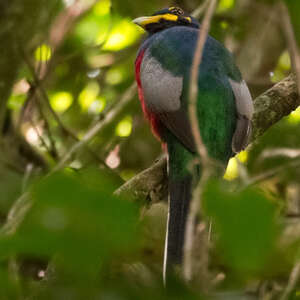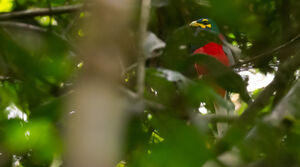Bare-cheeked Trogon
Apaloderma aequatoriale - Trogon à joues jaunes
Identification
The Bare-cheeked Trogon (or Trogon à joues jaunes in French) has been discovered by British ornithologist Richard Bowdler Sharpe (1847-1909) in 1901 in Cameroon. It is certainly one of the most mysterious birds of the moment, very few photos and observation recordings are available. It much looks like the Narina Trogon, but a bit smaller (28 to 31 cm) and sharing its territory. The male has a light yellow beak tinted greenish at its end, a dark brown iris and an unmistakable yellow mark above its eye. In succession of its beak, a yellow piece of skin shaped like two drops marks its cheek, a hallmark to distinguish the Bare-cheeked Trogon from the Narina Trogon and in particular its ssp constantia with only a small pale yellow mark below its eye. The head is emerald green with blue reflections on the throat and crown, starring out a green breast in contrast with the vivid red underparts; mantle, scapulars and back are also green. The small and middle coverts present gray and green horizontal waves, the big coverts, secondaries, and tertiaries are horizontally vermiculated in black and white, whereas primaries are black with white margins. Outer rectrices are white while central rectrices are blue-green. The female has a yellow beak with the upper jaw slightly grey and a very thin yellow eyebrows mark; however, she keeps the same yellow drops shaped marks below her eye. Her crown, nape, mantle and back are green. The throat, chest and upper belly are brownish-grey, whereas the belly keeps the red color noticed in the male; the vermiculations of the coverts and secondaries are more fuzzy, whereas primaries remain black with white margins.The legs are brown-pink but very difficult to see. The juveniles are paler, the chest is light brown, the belly is faintly green-striped and has not yet acquired the beautiful red colors of the adults, the wing coverts are coarsely brown and white mottled. The 'bare cheeks' are initially white and the bill is rather pale brown than yellow.
Subspecific information monotypic species
Foreign names
- Trogon à joues jaunes,
- Trogón carigualdo,
- republicano-de-lágrima,
- Gelbwangentrogon,
- Geelwangtrogon,
- Trogone guancenude,
- gulkindad trogon,
- Gulkinntrogon,
- trogónovec žltolíci,
- trogon žlutolící,
- Nøgenkindet Trogon,
- keltaposkitrogoni,
- trogon de galtes grogues,
- afrotrogon żółtolicy,
- Желтощёкий африканский трогон,
- ニシアフリカキヌバネドリ,
- 黄颊咬鹃,
- gulkindad trogon,
- 黃頰咬鵑,
Voice song and call
A plaintive chuu-chuu-chuu of 5 to 6 almost mournful notes which stops and then resumes every 15-20 seconds decreasing in intensity is the song of the Bare-cheeked Trogon. This species of the Narina Trogon also has a slow and rising whoou-whoou, as well as louder sharper calls that sound like an alarm.
Habitat
He prefers primary forest where he will fly up to 1,100 m, his typical habitat is the equatorial forest of the Congo Basin. He can also be found in managed forests where the canopy is relatively unharmed by man. The Bare-cheeked Trogon remains an avian strictly linked to the forest while the Narina Trogon is more all-terrain, making it one of the most difficult trogons to observe.
Behaviour character trait
Essentially sedentary.
Dietfeeding habits
The Bare-cheeked Trogon appears to be mainly insectivorous, they enjoy caterpillars, all kinds of beetles, orthoptera, mantises, stick insects and also Helixarion snails (soft-shelled snails). It is known that they often hunt on the ground.
Reproduction nesting
Bare-cheeked Trogon reproduces in January in Cameroon, January-February and November in Gabon, April and August in the Democratic Republic of the Congo - suggesting that there is no preference for a breeding season. The Bare-cheeked Trogon is monogamous and highly territorial, with a pair typically covering an area of 3 hectares and fiercely defending their territory, sometimes with the help of immature birds. In February 1976, French ornithologist André Brosset observed a group of six males, accompanied by a male Narina Trogon, join the mid-canopy of a primary forest and perch on different branches, with the birds fluttering their tails and ruffling their breast feathers. The birds were not aggressive towards each other but seemed to be in competition. This increased over a few days without any female birds being in sight. The nest is usually constructed in a natural hollow of a decaying large trunk at a height of 2 to 8 metres. The clutch is generally two eggs, with only the female incubating, an unusual trait according to American and Australian ornithologists Johnsgard and Forshaw as both parents usually share incubation in the Trogonidae family. Incubation lasts for 16 days and the chicks leave the nest after 16 to 17 days, with the male providing the lion's share of the feeding, particularly in the first few days.
Geographic range
Threats - protection
IUCN conservation status
concern
in the Wild
threatened
evaluated
The Bare-cheeked Trogon (LC) does not seem to be in danger, like other trogonids, it has adopted the maxim of live hidden, live better; bound to the equatorial forest, discreet and fearful, it preserves itself for the moment from human disturbances.
Sources of information
- IOC World Bird List (v15.1), Gill, F and D Donsker (Eds). 2025-12-07.
- A Natural history of the Trogonidae, Joseph M.Forshaw Albert Earl Gilbert
- Vol. 6 - Handbook of the Birds of the World, Josep del Hoyo-Andrew Elliott-Jordi Sargatal
- Scientific Birds Names, James A.Jobling
- xeno-canto, Sharing bird sounds from around the world,
- Avibase, Lepage Denis
- HBW Alive,
- Planet of Birds,
- The internet Bird Collection,
- Wikipédia, Wikipedia, The Free Encyclopedia
Other sources of interest
 Specification sheet created on
03/08/2023 by Anne et Gabriel Leboff
Specification sheet created on
03/08/2023 by Anne et Gabriel LeboffTranslation by AI Oiseaux.net
© 1996-2025 Oiseaux.net
- Accipitriformes
- Aegotheliformes
- Anseriformes
- Apodiformes
- Apterygiformes
- Bucerotiformes
- Caprimulgiformes
- Cariamiformes
- Casuariiformes
- Charadriiformes
- Ciconiiformes
- Coliiformes
- Columbiformes
- Coraciiformes
- Cuculiformes
- Eurypygiformes
- Falconiformes
- Galliformes
- Gaviiformes
- Gruiformes
- Leptosomiformes
- Mesitornithiformes
- Musophagiformes
- Nyctibiiformes
- Opisthocomiformes
- Otidiformes
- Passeriformes
- Pelecaniformes
- Phaethontiformes
- Phoenicopteriformes
- Piciformes
- Podargiformes
- Podicipediformes
- Procellariiformes
- Psittaciformes
- Pterocliformes
- Rheiformes
- Sphenisciformes
- Steatornithiformes
- Strigiformes
- Struthioniformes
- Suliformes
- Tinamiformes
- Trogoniformes




